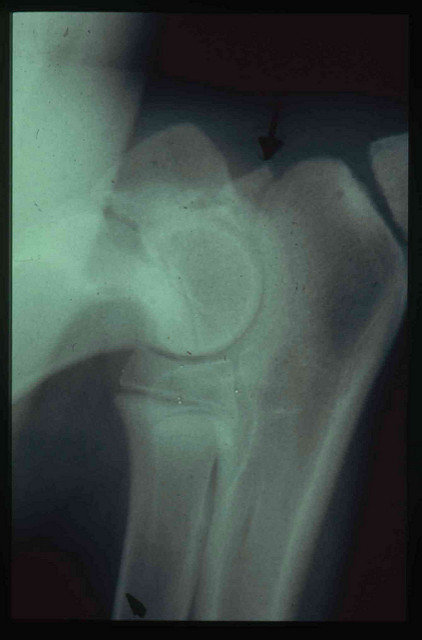Arthritis in Dogs
Dog Arthritis – What is It?
I’m sure you’ve heard of arthritis in humans – the inflammation of joints that make for an uncomfortable experience in everyday living. Did you know dogs are just as susceptible to arthritis as well? In fact, one in five dogs will experience arthritis in their lifetime. Most often affecting senior dogs, this degenerative joint disease takes many forms; however, the most common type of arthritis in dogs is osteoarthritis. Osteoarthritis is arthritis affecting multiple joints – the pain and discomfort felt as a result of arthritis is disruptive to daily life. In most cases of osteoarthritis, the cause of pain is the constant and abnormal rubbing within the joints due to joint instability.

In addition to osteoarthritis, other types of inflammatory joint disease in dogs can be caused by a number of factors, including: diabetes, bacterial or fungal infections, osteochondrosis, old injuries, increased activity levels in working dogs, obesity, and Cushing’s disease. The most common joint areas affected by arthritis in dogs are the hips, elbows, lower back, knees, and wrists.
In a healthy dog, the bone surfaces on the inside of a dog’s joints are covered with a thin layer of smooth cartilage which acts as a natural joint lubricant when the joints rub back and forth. If this layer of cartilage is damaged, the bones and joints rub together coarsely. This constant friction causes pain to the joints. In addition, the constant friction causes new bone growth to develop around the joints, which causes stiffness and limits joint movement. This additional bone growth is known as bone spurs.

What causes arthritis in dogs? Similar to humans, dogs experience arthritis due to natural aging, trauma, or situations when the joints do not develop properly (known as dysplasia). You might first notice your dog starting to limp here and there when they are moving around. Eventually, you will start to notice more progressive limping, stiffness, resting more often than usual, and a lack of energy and/or ability to do things they used to enjoy (e.g., running, jumping, going on walks, etc.).
What are the Symptoms of Arthritis in Dogs?
As mentioned above, the most classic symptoms of arthritis in dogs is limping and stiffness in the joints. A more complete list of potential symptoms includes:
- Lack of exercise
- Difficulty getting up after lying down
- Lameness in one or more legs
- Unexpected aggression toward humans or other dogs
- Lethargy
- Disinterest in jumping and running
- Difficulty climbing stairs
- Playing less
- Weight gain
- Changes in appetite
- Irritation when touched or petted
- Depression
- House soiling
- Sleeping more than usual
- Behavioral changes

If your dog is experiencing any of the above symptoms, it’s important that you take your dog to the veterinarian right away, as many illnesses and/or injuries can cause similar symptoms. Your veterinarian will do a thorough exam to rule out other causes and to diagnose the arthritis. A veterinarian will diagnose arthritis based on your dog’s age, your dog’s medical history, and a physical exam. Your veterinarian may also order X-rays of your dog’s joints to see how advanced the degeneration of the joints is.
Risk Factors of Arthritis in Dogs
While age is the most common risk factor for developing arthritis in dogs, other factors can make our furry friends more susceptible to this painful joint disease. These include:
- Larger breeds of dogs experience more arthritis than smaller breeds
- Being overweight causes more stress on the joints
- Hereditary or genetic factors
- Joint trauma in early life (or repeated trauma to the joints)
- Abnormal joint development
- Bacterial infections (can lead to chronic degenerative joint disease)
- Immune system irregularities
- Lyme disease (and other tick-borne illnesses)

If your dog has been diagnosed with arthritis, you might be wondering how long can your dog live with this disease, what are the complications, and is it treatable? If left untreated, dogs will be extremely uncomfortable with limited mobility. However, with proper treatment, most dogs will live comfortably with a normal life expectancy.
What are the Treatment Options for Arthritis in Dogs?
Because arthritis is worsened by obesity and lack of exercise, it is important that you keep your dog’s weight under control and their activity levels at a normal level. Non-medical treatment options in addition to drug therapy can be prescribed to treat arthritis in dogs. Pain medication will likely be prescribed to your dog to assist in the pain and discomfort felt due to the degeneration of the joints. In addition, anti-inflammatory pills will likely be prescribed, in addition to joint therapy treatments for a set period of time.
Non-medical treatment options for treating arthritis in dogs include:
- Weight management – to decrease further stress added to your dog’s joints
- Dietary changes – eating dog food with high levels of eicosapentaenoic acid (EPA), an omega-3 fatty acid that has shown to have success in decreasing joint inflammation
- Exercise – to help loosen stiff joints
- Physical rehabilitation – includes cold and heat therapy, canine massage, stretching, and range-of-motion exercises
- Acupuncture – to relieve pain in joints
These non-medical treatments may also be prescribed with drug treatments to further increase your dog’s comfort levels. There are three main families of drugs prescribed to treat arthritis in dogs: cartilage protectors, NSAIDS (anti-inflammatory drugs), and feed supplements.
Cartilage protectors reduce damage done to the cartilage in addition to promoting joint repair and reducing joint inflammation. Common types of cartilage protectors are hyaluronic acid, polysulphated glycosaminoglycans, and pentosan polysulphate

NSAIDs are anti-inflammatory drugs that manage the joint inflammation caused by arthritis. However, these types of drugs can cause some significant side effects in your dog. It is for this reason that NSAIDs are only prescribed on a short-term basis.
Feed supplements, most commonly called nutraceuticals are not drugs, rather dietary supplements. Nutraceuticals effective in treating arthritis in dogs typically contain chondroitin and glucosamine, which are naturally occurring in joint cartilage. Nutraceuticals like these are used to promote healthy joints (i.e., they can be used as preventative measures) in addition to decrease further development of joint damage when arthritis is present.
Can Arthritis be Cured?
Unfortunately, no. Once the cartilage in joints are damaged, they rarely undergo complete recovery. Does that mean there is no hope for your dog to live a life pain-free from arthritis? Absolutely not. Many dogs with arthritis live virtually pain-free lives with the proper treatment and management. If you suspect your dog may be suffering from arthritis, consult with your veterinarian immediately and explore all options to give your dog the best life possible.
